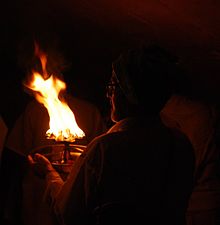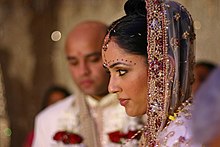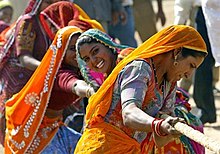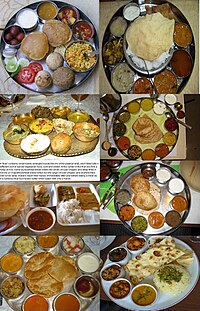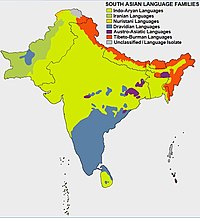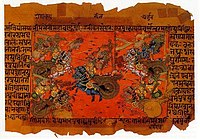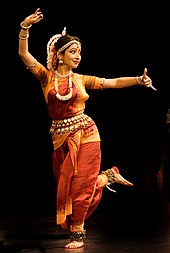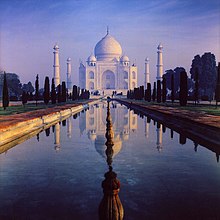Religions[edit]
India is the birthplace of
Hinduism,
Buddhism,
Jainism and
Sikhism, collectively known as Indian religions.
[3] Indian religions, also known as Dharmic religions are a major form of world religions along with
Abrahamic one. Today, Hinduism and Buddhism are the world's third and fourth-largest religions respectively, with over 2 billion followers altogether,
[4][5][6] and possibly as many as 2.5 or 2.6 billion followers.
[4][7]
India is one of the most religiously diverse nations in the world, with some of the most deeply religious societies and cultures. Religion still plays a central and definitive role in the life of many of its people.
According to a 2002 census of India, the religion of 80% of the people is Hinduism.
Islam is practised by around 13% of all Indians.
[8] The country had over 23 million Christians, over 19 million Sikhs, about 8 million Buddhists and about 4 million Jains.
[9]
Sikhism, Jainism and especially Buddhism are influential not only in India but across the world.
Christianity,
Zoroastrianism,
Judaism, and the
Bahá'í Faith are also influential but their numbers are smaller.
Atheism and
agnostics also have visible influence in India, along with a self-ascribed tolerance to other people.
The Hindu religion has many schools, each with their own unique views.
[10] For example, according to
Yogavasistha, a spiritual text of the Advaita school of Hindu religion, the values of the liberated (
Hindi: जीवन्मुक्ति), self-actualised human being, may be summarised as follows:
[11][12][13]"Pleasures do not delight him; pains do not distress. Although engaged in worldly actions, he has no attachment to any object. He is busy outwardly, yet calm inwardly. He feels free from restrictions of scriptures, customs, age, caste or creed. He is happy, but his happiness does not depend on anything else. He does not feel needy, proud, agitated, troubled, depressed or elated. He is full of compassion and forgiveness even to those who mean him harm. He does the right thing, regardless of the pressures. He is patient, perseverant, and without any impurity in his heart. He is free of delusions, he does not crave for anything. His sense of freedom comes from his spirit of inquiry. The fruits of his inquiry are his strength, intellect, efficiency and punctuality. He keeps company of wise and enlightened persons. He is content."
There is significant historical discourse in India on the notion, relevance, and the existence and non-existence of God.
Dharmakirti, for example, in the 7th century wrote in
Pramanavarttikam:
[14][15]
वेद प्रामाण्यं कस्य चित् कर्तृवादः स्नाने धर्मेच्छा जातिवादाव लेपः|
संतापारंभः पापहानाय चेति ध्वस्तप्रज्ञानां पञ्च लिङगानि जाड्ये||
Believing that the Veda are standard (holy or divine), believing in a Creator for the world,
Bathing in holy waters for gaining
punya, having pride (vanity) about one's job function,
Performing penance to absolve sins,
Are the five symptoms of having lost one's sanity.
Perceptions of Indian culture[edit]
India's diversity has inspired many writers to pen their perceptions of the country's culture. These writings paint a complex and often conflicting picture of the culture of India.
According to industry consultant Eugene M. Makar, for example, traditional Indian culture is defined by a relatively strict social hierarchy. He also mentions that from an early age, children are reminded of their roles and places in society.
[16] This is reinforced, Makar notes, by the way many believe gods and spirits have an integral and functional role in determining their life. Several differences such as religion divide the culture. However, a far more powerful division is
the traditional Hindu bifurcation into non-polluting and polluting occupations. Strict social taboos have governed these groups for thousands of years, claims Makar. In recent years, particularly in cities, some of these lines have blurred and sometimes even disappeared. He writes important family relations extend as far as
gotra, the mainly patrilinear lineage or clan assigned to a Hindu at birth. In rural areas & sometimes in urban areas as well, it is common that three or four generations of the family live under the same roof. The
patriarch often resolves family issues.
[16]
Others have a different perception of Indian culture. According to an interview with
C.K. Prahalad by Des Dearlove, author of many best selling business books, modern India is a country of very diverse cultures with many languages, religions and traditions. Children begin by coping and learning to accept and assimilate in this diversity. Prahalad - who was born in India and grew up there - claimed, in the interview, that Indians, like everyone else in the world, want to be treated as unique, as individuals, want to express themselves and seek innovation.
[17] In another report, Nancy Lockwood of
Society for Human Resource Management, the world's largest human resources association with members in 140 countries, writes that in the past two decades or so, social change in India is in dramatic contrast to the expectations from traditional Indian culture. These changes have led to Indian families giving education opportunities to girls, accepting women working outside home, pursuing a career, and opening the possibility for women to attain managerial roles in corporate India. Lockwood claims that change is slow, yet the scale of cultural change can be sensed from the fact that of India's 397 million workers, 124 million are now women. The issues in India with women empowerment are similar to those elsewhere in the world.
[18]
According to
Amartya Sen, the India born Nobel Laureate in Economics, the culture of modern India is a complex blend of its historical traditions, influences from the effects of colonialism over centuries and current Western culture - both collaterally and dialectically. Sen observes that external images of India in the West often tend to emphasise the difference - real or imagined - between India and the West.
[19] There is a considerable inclination in the Western countries to distance and highlight the differences in Indian culture from the mainstream of Western traditions, rather than discover and show similarities. Western writers and media usually misses, in important ways, crucial aspects of Indian culture and traditions. The deep-seated heterogeneity of Indian traditions, in different parts of India, is neglected in these homogenised description of India. The perceptions of Indian culture, by those who weren't born and raised in India, tend to be one of at least three categories, writes Sen:
- Exoticist approach: it concentrates on the wondrous aspects of the culture of India. The focus of this approach of understanding Indian culture is to present the different, the strange and as Hegel put it, "a country that has existed for millennia in the imaginations of the Europeans."
- Magisterial approach: it assumes a sense of superiority and guardianship necessary to deal with India, a country that James Mill's imperialist history thought of as grotesquely primitive culture. While great many British observers did not agree with such views of India, and some non-British ones did, it is an approach that contributes to some confusion about the culture of India.
- Curatorial approach: it attempts to observe, classify and record the diversity of Indian culture in different parts of India. The curators do not look only for the strange, are not weighed by political priorities, and tend to be more free from stereotypes. The curatorial approach, nevertheless, have an inclination to see Indian culture as more special and extraordinarily interesting than it actually may be.
The curatorial approach, one inspired by systematic curiosity for the cultural diversity of India within India, is mostly absent.
Susan Bayly, in her book, observes that there is considerable dispute in India and Orientalist scholars on perceived Indian culture. She acknowledges that many dispute claims of pervasiveness of caste and strict social hierarchy in modern India. Bayly notes that much of the Indian subcontinent was populated by people for whom the formal distinctions of caste and strict social hierarchies were of only limited importance in their lifestyles.
[20]
According to Rosser, an American sociologist, Americans of South Asian origins feel the Western perception of the culture of India has numerous stereotypes. Rosser notes that the discourse in much of the United States about the culture of India is rarely devoted to independent India. People quickly make sweeping and flawed metaphysical assumptions about its religion and culture, but are far more circumspect when evaluating civil society and political culture in modern India. It is as if the value of South Asia resides only in its ancient contributions to human knowledge whereas its pathetic attempts to modernise or develop are to be winked at and patronised.
[21] Rosser conducted numerous interviews and summarised the comments. The study reports a stark contrast between Western perceptions of the culture of India, versus the direct experience of the interviewed people. For example:
"The presentation of South Asians is a standard pedagogic approach which runs quickly from the "Cradle of Civilisation"—contrasting the Indus Valley with Egypt and Mesopotamia—on past the Aryans, who were somehow our ancestors— to the poverty stricken, superstitious, polytheistic, caste ridden Hindu way of life. . . and then somehow magically culminates with a eulogy of Mahatma Gandhi. A typical textbook trope presents the standard Ancient India Meets the Age of Expansion Approach with a colour photo of the Taj Mahal. There may be a side bar on ahimsa or a chart of connecting circles graphically explaining samsara and reincarnation, or illustrations of the four stages of life or the Four Noble Truths. Amid the dearth of real information there may be found an entire page dedicated to a deity such as Indra or Varuna, who admittedly are rather obscure vis-à-vis the beliefs of most modern Hindus."
— A South Asian in America
[21]
Family structure and marriage[edit]
For generations, India has had a prevailing tradition of the joint family system. It is a system under which extended members of a family – parents, children, the children’s spouses and their offspring, etc. – live together. Usually, the oldest male member is the head in the joint Indian family system. He makes all important decisions and rules, and other family members abide by them.
[22]
In a 1966 study, Orenstein and Micklin analysed India's population data and family structure. Their studies suggest that Indian household sizes had remained similar over the 1911 to 1951 period. Thereafter, with urbanisation and economic development, India has witnessed a break up of traditional joint family into more nuclear-like families.
[23][24]
Sinha, in his book, after summarising the numerous sociological studies done on Indian family, notes that over the last 60 years, the cultural trend in most parts of India has been an accelerated change from joint family to nuclear families, much like population trends in other parts of the world. The traditional large joint family in India, in the 1990s, accounted for a small percent of Indian households, and on average had lower per capita household income. He finds that joint family still persists in some areas and in certain conditions, in part due to cultural traditions and in part due to practical factors.
[23] Youth in lower socio-economic classes are more inclined to spend time with their families than their peers due to differing ideologies in rural and urban parenting.
[25]
Arranged Marriage[edit]
For centuries,
arranged marriages have been the tradition in Indian society. Even today, the majority of Indians have their marriages planned by their parents and other respected family-members. In the past, the age of marriage was young, especially in Rajasthan, but this is rising with modernisation and there are now laws which govern the age of marriage.
[26]
In most marriages the bride's family provide a dowry to the bridegroom. Traditionally, the dowry was considered a woman's share of the family wealth, since a daughter had no legal claim on her natal family's real estate. It also typically included portable valuables such as jewellery and household goods that a bride could control throughout her life.
[27] Historically, in most families the inheritance of family estates passed down the male line. Since 1956, Indian laws treat males and females as equal in matters of inheritance without a legal will.
[28] Indians are increasingly using a legal will for inheritance and property succession, with about 20 percent using a legal will by 2004.
[29]
In India, the divorce rate is low — 1% compared with about 40% in the United States.
[30][31] These statistics do not reflect a complete picture, though. There is a dearth of scientific surveys or studies on Indian marriages where the perspectives of both husbands and wives were solicited in-depth. Sample surveys suggest the issues with marriages in India are similar to trends observed elsewhere in the world. The divorce rates are rising in India. Urban divorce rates are much higher. Women initiate about 80 percent of divorces in India.
[32]- "Opinion is divided over what the phenomenon means: for traditionalists the rising numbers portend the breakdown of society while, for some modernists, they speak of a healthy new empowerment for women."[33]
Recent studies suggest that Indian culture is trending away from traditional arranged marriages.
Banerjee et al. surveyed 41,554 households across 33
states and union territories in India in 2005. They find that the marriage trends in India are similar to trends observed over last 40 years in China, Japan and other nations.
[34] The study found that fewer marriages are purely arranged without consent and that the majority of surveyed Indian marriages are arranged with consent. The percentage of self-arranged marriages (called love marriages in India) were also increasing, particularly in the urban parts of India. A 2006 article reported that between 10 and 20 percent of marriages in urban India were self-arranged.
[35]
Wedding rituals[edit]
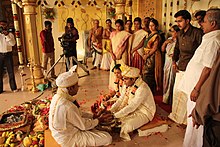
A Hindu wedding ritual in progress. The bride and the groom are seated together, receiving instructions from the priest. The sacred square fire container (
yajna kund) is behind the priest.
Weddings are festive occasions in India with extensive decorations, colors, music, dance, costumes and rituals that depend on the religion of the bride and the groom, as well as their preferences.
[36] The nation celebrates about 10 million weddings per year,
[37] of which over 80% are
Hindu weddings.
While there are many festival-related rituals in Hinduism,
vivaha (wedding) is the most extensive personal ritual an adult Hindu undertakes in his or her life.
[38][39] Typical Hindu families spend significant effort and financial resources to prepare and celebrate weddings. The rituals and process of a Hindu wedding vary depending on region of India, local adaptations, resources of the family and preferences of the bride and the groom. Nevertheless, there are a few
key rituals common in
Hindu weddings -
Kanyadaan,
Panigrahana, and
Saptapadi; these are respectively, gifting away of daughter by the father, voluntarily holding hand near the fire to signify impending union, and taking seven steps before fire with each step including a set of mutual vows. After the seventh step and vows of
Saptapadi, the couple is legally husband and wife.
[39][40][41] Indian Sikh weddings and Jain weddings have similar rituals as Hindus, but with some key differences. The rituals are sometimes called by different names as well; for example, the steps ritual in front of fire is called
Laava Phere by Sikhs instead of
Saptapadi.
Indian Muslims celebrate a traditional
Islamic wedding following customs similar to those practiced in the Middle East. The rituals include
Nikah, payment of financial dower called
Mahr by the groom to the bride, signing of marriage contract, and a reception.
[42] Indian
Christian weddings follow customs similar to those practiced in the Christian countries in the West.
Greetings[edit]
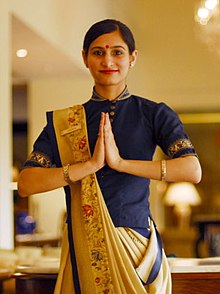
Pressing hands together with a smile to greet Namaste - a common cultural practice in India.
Namaste (Hindi),
Namaskar (Marathi) or
Namaskara (
Kannada) or
Namaskaram (
Telugu,
Malayalam),
Vanakkam (
Tamil),
Nomoshkaar (
Bengali),
Nomoskar (
Assamese) is a common spoken greeting or salutation, though becoming considered old-fashioned by some. Namaskar is considered a slightly more formal version than Namaste but both express deep respect. It is commonly used in India and
Nepal by
Hindus, Jains and Buddhists, and many continue to use this outside the (
Indian subcontinent). In Indian and Nepali culture, the word is spoken at the beginning of written or verbal communication. However, the same hands folded gesture is made usually wordlessly upon departure. Taken literally, it means "I bow to you". The word is derived from
Sanskrit (namah): to
bow,
obeisance, reverential
salutation, and
respect, and (te): "to you". As explained by an Indian scholar, in literal terms Namaste refers to 'Godliness in me bows to Godliness in you' or 'Divinity in me, salutes divinity in you'. In most Indian families, younger men and women are taught to seek the blessing of their elders by reverentially bowing to their elders. This custom is known as
Pranāma.
These traditional forms of greeting are no longer used in the world of business and in India's urban environment. The handshake is the common form of greeting between men and men and also between women and women; the handshake is often long and soft. Men should greet Indian women with a slight nod unless the woman offers her hand for a short shake.
[43]
Festivals[edit]

With India's cultural diversity, the country has more festivals than there are days in a year. With little lamps and lot of care,
Karthigai festival celebrates the bond between sisters and brothers in south India. In other parts of India,
Bhaiya-Dhuj and
Raakhi is celebrated. Sisters wish their brothers happiness and feed them sweets, while brothers give gifts and promise to protect their sisters.
India, being a multi-cultural and multi-religious society, celebrates holidays and festivals of various religions. The three
national holidays in India, the
Independence Day, the
Republic Day and the
Gandhi Jayanti, are celebrated with zeal and enthusiasm across India. In addition, many
Indian states and regions have local festivals depending on prevalent religious and linguistic demographics. Popular religious festivals include the Hindu festivals of
Navratri,
Diwali,
Maha Shivratri,
Ganesh Chaturthi,
Durga puja,
Holi,
Ugadi,
Rakshabandhan, and
Dussehra. Several
harvest festivals such as
Sankranthi,
Pongal,
Raja sankaranti swinging festival, and
Onam, "
Nuakhai" are also fairly popular.
Certain festivals in India are celebrated by multiple religions. Notable examples include Diwali, which is celebrated by Hindus, Sikhs and Jains, and
Buddh Purnima, celebrated by Buddhists. Sikh Festivals, such as
Guru Nanak Jayanti,
Baisakhi are celebrated with full fanfare by Sikhs and Hindu. Adding colours to the culture of India, the
Dree Festival is one of the tribal festivals of India celebrated by the Apatanis of the Ziro valley of
Arunachal Pradesh, which is the easternmost state of India.
Christianity is India's third largest religion. With over 23 million Christians, of which 17 million are Roman Catholics, India is home to many Christian festivals. The country celebrates
Christmas and
Good Friday as public holidays.
[44]
Regional fairs are also common and festive in India. For example, Pushkar fair is one of the world's largest markets and Sonepur mela is the largest livestock fair in Asia.
[45]
Names and language[edit]
Indian names are based on a variety of systems and
naming conventions, which vary from region to region. Names are also influenced by religion and caste and may come from the Indian epics.
Animals[edit]
In Hinduism, the cow is regarded as a symbol of
ahimsa (non-violence),
mother goddess and bringer of good fortune and wealth.
[47] For this reason, cows are revered in Hindu culture and feeding a cow is seen as an act of worship.
[48]
As of January 2012, cow remains a divisive topic in India. Several states of India have passed laws to protect cows, while many states have no restrictions on the production and consumption of beef. Some groups oppose the butchering of cows, while other Indian groups are vehement that what kind of meat one eats ought to be a matter of personal choice in a democracy.
Madhya Pradesh enacted a law in January 2012, namely the Gau-Vansh Vadh Pratishedh (Sanshodhan) Act, which makes cow slaughter a serious offence. Gujarat, a western state of India, has the Animal Preservation Act, enacted in October 2011, that prohibits killing of cows along with buying, selling and transport of beef. In contrast, Odisha and Andhra Pradesh allow butchering of cattle with a fit-for-slaughter certificate. In the states of West Bengal and Kerala, consumption of beef is not deemed an offence. Contrary to stereotypes, a sizeable number of Hindus eat beef, and many argue that their scriptures, such as vedic texts, do not prohibit its consumption. In southern Indian state Kerala, for instance, beef accounts for nearly half of all meat consumed by all communities, including Hindus. Sociologists theorise that the widespread consumption of cow meat in India is because it is a far cheaper source of animal protein for the poor than lamb or chicken, which retail at double the price. For these reasons, India's beef consumption post-independence in 1947 has witnessed a much faster growth than any other kind of meat; currently, India is one of the five largest producer and consumer of cattle livestock meat in the world. While states such as Madhya Pradesh are passing local laws to prevent cruelty to cows, other Indians are arguing "If the real objective is to prevent cruelty to animals, then why single out the cow when hundreds of other animals are maltreated?"
[49][50][51]
Cuisine[edit]
Main article:
Indian cuisine
Indian cuisine is diverse, ranging from very spicy to very mild, varying with seasons in each region. These reflect the
local agriculture,
regional climate, culinary innovations and cultural diversity. Food in India is sometimes served in
thali - a plate with rice, bread and a selection of sides. Above are thali samples.

Nimmatnama-i Nasiruddin-Shahi (Book of Recipes), written about 1500 AD, documents the fine art of making
Kheer, a milk based dessert of India: Select the cows carefully; to get quality milk, pay attention to what the cows eat; feed them sugar canes; use this milk to make the best
Kheer.

Kheer is a traditional Indian sweet dish.
Food is an integral part of every human culture. Chang notes that the importance of food in understanding human culture lies in its infinite variability - a variability that is not essential for species survival. For survival needs, people everywhere could eat the same and some simple food.
[52] But human cultures, over the ages, experiment, innovate and develop sophisticated cuisines. Cuisines become more than a source of nutrients, they reflect human knowledge, culture, art and expression of love.
Indian food is as diverse as India. Indian cuisines use numerous ingredients, deploy a wide range of food preparation styles, cooking techniques and culinary presentation. From salads to sauces, from vegetarian to meat, from spices to sensuous, from breads to desserts, Indian cuisine is invariably complex. Harold McGee, a favourite of many Michelin-starred chefs, writes "for sheer inventiveness with milk itself as the primary ingredient, no country on earth can match India."
[53]
"I travel to India at least three to four times a year. It’s always inspirational. There is so much to learn from India because each and every state is a country by itself and each has its own cuisine. There are lots of things to learn about the different cuisines - it just amazes me. I keep my mind open and like to explore different places and pick up different influences as I go along. I don’t actually think that there is a single state in India that I haven’t visited. [...] Indian food is a cosmopolitan cuisine that has so many ingredients. I don’t think any cuisine in the world has got so many influences the way that Indian food has. It is a very rich cuisine and is very varied. Every region in the world has their own sense of how Indian food should be perceived. "
"...it takes me back to the first Christmas I can remember, when the grandmother I hadn’t yet met, who was Indian and lived in England, sent me a box. For me it still carries the taste of strangeness and confusion and wonder."
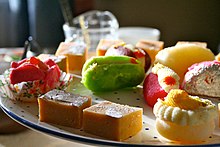
Some Indian
desserts from hundreds of varieties. In certain parts of India, these are called
mithai or sweets. Sugar and desserts have a long history in India: by about 500 BCE, people in India had developed the technology to produce sugar crystals. In the local language, these crystals were called
khanda (खण्ड), which is the source of the word
candy.
[56]
According to
Sanjeev Kapoor, a member of Singapore Airlines’ International Culinary Panel, Indian food has long been an expression of world cuisine. Kapoor claims, "if you looked back in India's history and study the food that our ancestors ate, you will notice how much attention was paid to the planning and cooking of a meal. Great thought was given to the texture and taste of each dish.”
[57] One such historical record is
Mānasollāsa, (
Sanskrit:
मानसोल्लास, The Delight of Mind), written in the 12th century. The book describes the need to change cuisine and food with seasons, various methods of cooking, the best blend of flavours, the feel of various foods, planning and style of dining amongst other things.
[58]
India is known for its love for food and spices. Indian cuisine varies from region to region, reflecting the local produce, cultural diversity, and
varied demographics of the country. Generally, Indian cuisine can be split into five categories -
northern,
southern, eastern, western, and north-eastern. The diversity of Indian cuisine is characterised by differing use of many
spices and herbs, a wide assortment of recipes and cooking techniques. Though a significant portion of Indian food is
vegetarian, many traditional Indian dishes also include chicken, goat, lamb, fish, and other meats. Fish-based cuisines are common in eastern states of India, particularly
West Bengal.
[59]
Despite this diversity, some unifying threads emerge. Varied uses of spices are an integral part of certain food preparations, and are used to enhance the flavour of a dish and create unique flavours and aromas. Cuisine across India has also been influenced by various cultural groups that entered India throughout history, such as the
Persians,
Mughals, and
European colonists.
Indian cuisine is one of the most popular cuisines across the globe.
[60] In most Indian restaurants outside India, the menu does not do justice to the enormous variety of Indian cuisine available - the most common cuisine served on the menu would be
Punjabi cuisine (
chicken tikka masala is a very popular dish in the United Kingdom). There do exist some restaurants serving cuisines from other regions of India, although these are few and far between. Historically, Indian spices and herbs were one of the most sought after trade commodities. The
spice trade between India and Europe led to the rise and dominance of Arab traders to such an extent that European explorers, such as
Vasco da Gama and
Christopher Columbus, set out to find new trade routes with India leading to the
Age of Discovery.
[61] The popularity of
curry, which originated in India, across Asia has often led to the dish being labeled as the "pan-Asian" dish.
[62]
Regional Indian cuisine continues to evolve. A fusion of East Asian and Western cooking methods with traditional cuisines, along with regional adaptations of fast food are prominent in major Indian cities.
[63]
Clothing[edit]
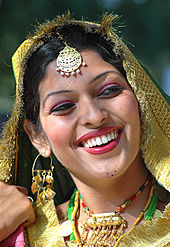
Punjabi woman dressed traditionally for 'Teej' festival.
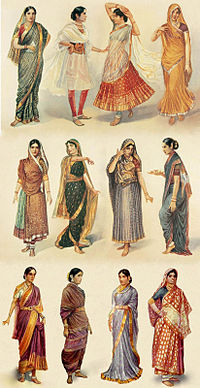
Illustration of different styles of
Sari& clothing worn by women in India.
Traditional
clothing in India greatly varies across different parts of the country and is influenced by local culture, geography, climate and rural/urban settings. Popular styles of dress include draped garments such as
sari for women and
dhoti or
lungi or panche (in Kannada) for men. Stitched clothes are also popular such as
churidar or
salwar-kameez for women, with
dupatta (long scarf) thrown over shoulder completing the outfit. Salwar is often loose fitting, while churidar is a tighter cut.
[64] For men, stitched versions include
kurta-
pyjama and European-style trousers and shirts for men. In urban centres, people can often be seen in jeans, trousers, shirts, suits, kurtas and variety of other fashions.
In public and religious places, Indian dress etiquette discourages exposure of skin and wearing transparent or tight clothes.
[65] Most Indian clothes are made from
cotton which is ideal for the region's hot weather.
[66] Since India's weather is mostly hot and rainy, majority of Indians wear
sandals.
[67]
Indian women perfect their sense of charm and fashion with make up and ornaments. Bindi, mehendi, earrings, bangles and other jewelry are common. On special occasions, such as marriage ceremonies and festivals, women may wear cheerful colours with various ornaments made with gold, silver or other regional stones and gems.
Bindi is often an essential part of a Hindu woman's make up. Worn on their forehead, some consider the
bindi as an auspicious mark. Traditionally, the red bindi was worn only by married Hindu women, and coloured bindi was worn by single women, but now all colours and glitter has become a part of women's fashion. Some women wear
sindoor - a traditional red or orange-red powder (vermilion) in the parting of their hair (locally called
mang). Sindoor is the traditional mark of a married woman for Hindus. Single Hindu women do not wear
sindoor; neither do over 100 million Indian women from religions other than Hindu and agnostics/atheists who may be married.
[64]
India's clothing styles have continuously evolved over the course of the country's history. The 11th-century BCE
Rig-veda mentions dyed and embroidered garments (known as
paridhan and
pesas respectively) and thus highlights the development of sophisticated garment manufacturing techniques during this period.
[68] In 5th century BCE, Greek historian
Herodotus describes the richness of the quality of Indian cotton clothes.
[69] By the 2nd century AD,
muslinsmanufactured in southern India were imported by the
Roman Empire and silk cloth was one of the major exports of ancient India along with
Indian spices.
[70] Stitched clothing in India was developed before the 10th century CE and was further popularised in the 15th century by Muslim empires in India.
[70] Draped clothing styles remained popular with India's Hindu population while the Muslims increasingly adopted tailored garments.
[71]
During the
British Raj, India's large clothing and handicrafts industry was left paralysed so as to make place for British industrial cloth. Consequently, Indian independence movement leader
Mahatma Gandhi successfully advocated for what he termed as
khadi clothing — light coloured hand-woven clothes — so as to decrease the reliance of the Indian people on British industrial goods.
[72] The 1980s were marked by a widespread modification to Indian clothing fashions which was characterised by a large-scale growth of fashion schools in India, increasing involvement of women in the fashion industry and changing Indian attitudes towards multiculturalism. These developments played a pivotal role in the fusion of Indian and Western clothing styles.
[73]
Languages and literature[edit]
History[edit]
Language families in India and its neighbouring countries. India has 22 official languages – 15 of which are
Indo-European. The 2001 census of India found 122
first languages in active use. The second map shows the distribution of the Indo-European languages throughout the world.
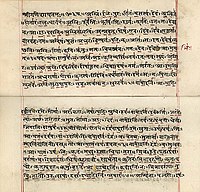
Rigveda (
padapatha) manuscript in
Devanagari, early 19th century. After a scribal benediction (
"śrīgaṇéśāyanamaḥ ;; Aum(3) ;;"), the first line has the opening words of RV.1.1.1 (
agniṃ ; iḷe ; puraḥ-hitaṃ ; yajñasya ; devaṃ ; ṛtvijaṃ). The
Vedic accent is marked by underscores and vertical overscores in red.
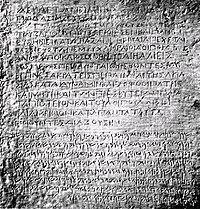
Literary records suggest India had interacted in languages of other ancient civilisations. This inscription is from Indian emperor Ashoka, carved in stone about 250 BCE, found in Afghanistan. Inscriptions are in
Greek and
Aramaic, with ideas of non-violence against men and all living beings, as the doctrine of
Eusebeia - spiritual maturity.
The Sanskrit language, whatever be its antiquity, is of a wonderful structure; more perfect than the Greek, more copious than the Latin, and more exquisitely refined than either, yet bearing to both of them a stronger affinity, both in the roots of verbs and the forms of grammar, than could possibly have been produced by accident; so strong indeed, that no philologer could examine them all three, without believing them to have sprung from some common source, which, perhaps, no longer exists; there is a similar reason, though not quite so forcible, for supposing that both the Gothic and the Celtic, though blended with a very different idiom, had the same origin with the Sanskrit [...]
— Sir William Jones, 1786
[74]
The
Rigvedic Sanskrit is one of the oldest attestations of any
Indo-Aryan language, and one of the earliest attested members of the
Indo-European language family. The discovery of Sanskrit by early European explorers of India led to the development of comparative Philology. The scholars of the 18th century were struck by the far reaching similarity of Sanskrit, both in grammar and vocabulary, to the classical languages of Europe. Intensive scientific studies that followed have established that Sanskrit and many Indian derivative languages belong to the family which includes English, German, French, Italian, Spanish, Celtic, Greek, Baltic, Armenian, Persian, Tocharian and other Indo-European languages.
[75]
The evolution of language within India may be distinguished over three periods: old, middle and modern Indo-Aryan. The classical form of old Indo-Aryan was
sanskrit meaning polished, cultivated and correct, in distinction to
Prakrit- the practical language of the migrating masses evolving without concern to proper pronunciation or grammar, the structure of language changing as those masses mingled, settled new lands and adopted words from people of other native languages.
Prakrita became middle Indo-Aryan leading to
Pali (the language of early Buddhists and Ashoka era in 200-300 BCE),
Prakrit (the language of Jain philosophers) and
Apabhramsa (the language blend at the final stage of middle Indo-Aryan). It is
Apabhramsa, scholars claim,
[75] that flowered into Hindi, Gujarati, Bengali, Marathi, Punjabi and many other languages now in use in India's north, east and west. All of these Indian languages have roots and structure similar to Sanskrit, to each other and to other Indo-European languages. Thus we have in India three thousand years of continuous linguistic history recorded and preserved in literary documents. This enables scholars to follow language evolution and observe how, by changes hardly noticeable from generation to generation, an original language alters into descendant languages that are now barely recognisable as the same.
[75]
Hindi is mutually intelligible with
Urdu, both languages being standardised registers of
Hindustani. Whilst Hindi is often associated with Hinduism, Urdu is generally associated with South Asian Muslims. The main difference between the two is that Hindi is generally written in the
Devanagari script, whilst Urdu is written in
Nastaliq, but, when spoken colloquially, both are mutually intelligible. Mutual intelligibility decreases, however, in specialised contexts where Urdu has borrowed words from Persian and Arabic, whilst Hindi has done so from Sanskrit and English.
Tamil, one of India's major classical language, descends from
Proto-Dravidian languages spoken around the third millennium BCE in peninsular India.
Tamil literature has existed for over two thousand years
[80] and the earliest
epigraphic records found date from around the 3rd century BCE.
[81]
Telugu, one of India's major classical language, descends from South-Central Dravidian language spoken around the third millennium BCE in all over south India. Early inscriptions date from 620 AD and literary texts from the 11th century, written in a Telugu script adapted from the Bhattiprolu script of the early inscriptions.
Another major Classical Dravidian language,
Kannada is attested epigraphically from the mid-1st millennium AD, and literary
Old Kannada flourished in the 9th- to 10th-century
Rashtrakuta Dynasty. As a spoken language, some believe it to be even older than Tamil due to the existence of words which have more primitive forms than in Tamil. Pre-old Kannada (or
Purava HazheGannada) was the language of
Banavasi in the early Common Era, the
Satavahana and
Kadamba periods and hence has a history of over 2000 years.
[82][83][84][85] The
Ashoka rock edictfound at
Brahmagiri (dated 230 BCE) has been suggested to contain a word in identifiable Kannada.
[86]
In addition to Indo-European and Dravidian languages, Austro-Asiatic and Tibeto-Burman languages are in use in India. Genomic studies of ethnic groups in India suggests the Austro-Asiatic tribals were likely the earliest settlers in India. India's language and cultural fusion is not only because of large migrations of Indo-Aryans from central Asia and west Eurasia through the northwest, the genome studies suggest a major wave of humans possibly entered India, long ago, through the northeast, along with tribal populations of Tibeto-Burman origins. Genome studies of
Fstdistances suggest the northeastern Himalayas acted as a barrier, in the last 5000 years, to human migration as well as to admixing. Languages spoken in this part of India include Austro-Asiatic (e.g.
Khasi) and Tibeto-Burman (e.g.
Nishi).
[87][88][89][90][91]
According to the 2001 and 2011 India census, Hindi is the most spoken language in India, followed by
Bengali, Telugu,
Marathi, Tamil and
Urdu.
[92] In contemporary Indian literature, there are two major literary awards; these are the
Sahitya Akademi Fellowship and the
Jnanpith Award. Eight Jnanpith awards have been awarded in Kannada, six in Hindi, five in
Bengali, four in
Malayalam, three each in Marathi,
Gujarati,
Urdu and
Oriya and two each in
Assamese, Telugu and Tamil.
The
Rāmāyaṇa and the
Mahābhārata are the oldest preserved and well-known epics of India. Versions have been adopted as the epics of Southeast Asian countries like Philippines, Thailand, Malaysia and Indonesia. The Ramayana consists of 24,000 verses in seven books (
kāṇḍas) and 500
cantos(
sargas),
[93] and tells the story of Rama (an incarnation or
Avatar of the Hindu preserver-god
Vishnu), whose wife
Sita is abducted by the
demon king of
Lanka,
Ravana. This epic played a pivotal role in establishing the role of
dhárma as a principal ideal guiding force for Hindu way of life.
[94] The earliest parts of the Mahabharata text date to 400 BC
[94] and is estimated to have reached its final form by the early
Gupta period (c. 4th century AD).
[95] Other regional variations of these, as well as unrelated epics include the Tamil
Ramavataram, Kannada
Pampa Bharata, Hindi
Ramacharitamanasa, and Malayalam
Adhyathmaramayanam. In addition to these two great Indian epics, there are five major epics in the classical
Tamil language —
Silappatikaram,
Manimekalai,
Civaka-cintamani and
Valayapathi, kundalakesi.
Performing arts[edit]
Main article:
Dance in India
Let drama and dance (Nātya, नाट्य) be the fifth vedic scripture. Combined with an epic story, tending to virtue, wealth, joy and spiritual freedom, it must contain the significance of every scripture, and forward every art.
— First chapter of
Nātyaśāstra, sometime between 200BC - 200AD
[96][97]
India has had a long romance with the art of dance.
Nātyaśāstra (Science of Dance) and
Abhinaya Darpana (Mirror of Gesture) are two surviving Sanskrit documents, both estimated to be between 1700 to 2200 years old.
[97]
The Indian art of dance as taught in these ancient books, according to Ragini Devi, is the expression of inner beauty and the divine in man.
[98] It is a deliberate art, nothing is left to chance, each gesture seeks to communicate the ideas, each facial expression the emotions.
Recent developments include adoption of international dance forms particularly in the urban centres of India, and the extension of Indian classical dance arts by the Kerala Christian community, to tell stories from the Bible.
[101]
Drama and theatre[edit]
Images of musical instruments drawn by Pierre Sonnerat, the French explorer, in 1782 during his voyage through India.
Main article:
Music of India
Music is an integral part of India's culture.
Natyasastra, a 2000-year-old Sanskrit text, describes five systems of taxonomy to classify musical instruments.
[105] One of these ancient Indian systems classifies musical instruments into four groups according to four primary sources of vibration: strings, membranes, cymbals, and air. According to Reis Flora, this is similar to the Western theory of organology. Archeologists have also reported the discovery of a 3000-year-old, 20-key, carefully shaped polished basalt lithophone in the
highlands of Odisha.
[106]
The oldest preserved examples of Indian music are the melodies of the
Samaveda (1000 BC) that are still sung in certain Vedic
Śrauta sacrifices; this is the earliest account of Indian musical hymns.
[107] It proposed a tonal structure consisting of seven notes, which were named, in descending order, as
Krusht,
Pratham,
Dwitiya,
Tritiya,
Chaturth,
Mandra and
Atiswār. These refer to the notes of a flute, which was the only fixed frequency instrument. The Samaveda, and other
Hindu texts, heavily influenced
India's classical music tradition, which is known today in two distinct styles:
Carnatic and
Hindustani music. Both the Carnatic music and Hindustani music systems are based on the melodic base (known as
Rāga), sung to a rhythmic cycle (known as
Tāla); these principles were refined in the
nātyaśāstra (200 BC) and the
dattilam (300 AD).
[108]
The current music of India includes multiple varieties of religious, classical,
folk, popular and pop music.
Prominent contemporary Indian musical forms included
filmi and
Indipop. Filmi refers to the wide range of music written and performed for mainstream
Indian cinema, primarily
Bollywood, and accounts for more than 70 percent of all music sales in the country.
[109] Indipop is one of the most popular contemporary styles of Indian music which is either a fusion of
Indian folk, classical or
Sufi music with Western musical traditions.
[110]
Visual arts[edit]
Painting[edit]
Cave paintings from
Ajanta,
Bagh,
Ellora and
Sittanavasal and temple paintings testify to a love of naturalism. Most early and medieval art in India is Hindu, Buddhist or Jain. A freshly made coloured flour design (
Rangoli) is still a common sight outside the doorstep of many (mostly South Indian) Indian homes.
Raja Ravi Varma is one the classical painters from medieval India.
Madhubani painting,
Mysore painting,
Rajput painting,
Tanjore painting,
Mughal painting are some notable Genres of Indian Art; while
Nandalal Bose,
M. F. Husain,
S. H. Raza,
Geeta Vadhera,
Jamini Roy and B.Venkatappa
[111] are some modern painters. Among the present day artists, Atul Dodiya, Bose Krishnamacnahri,
Devajyoti Ray and Shibu Natesan represent a new era of Indian art where global art shows direct amalgamation with Indian classical styles. These recent artists have acquired international recognition.
Jehangir Art Gallery,
Mumbai,
Mysore Palace has on display a few good Indian paintings.
Sculpture[edit]

The 5th-century Buddhist
vishvakarma cave at
Ellora, Maharashtra.

Marble Sculpture of female, c. 1450, Rajasthan
The first
sculptures in India date back to the
Indus Valley civilisation, where stone and bronze figures have been discovered. Later, as Hinduism, Buddhism, and Jainism developed further, India produced some extremely intricate
bronzes as well as temple carvings. Some huge shrines, such as the one at
Ellora were not constructed by using blocks but carved out of solid rock.
Sculptures produced in the northwest, in
stucco,
schist, or
clay, display a very strong blend of Indian and Classical
Hellenistic or possibly even
Greco-Roman influence. The pink
sandstone sculptures of
Mathura evolved almost simultaneously. During the
Gupta period (4th to 6th centuries) sculpture reached a very high standard in execution and delicacy in modeling. These styles and others elsewhere in India evolved leading to classical Indian art that contributed to Buddhist and Hindu sculpture throughout Southeast Central and East Asia.
Architecture[edit]
Indian architecture encompasses a multitude of expressions over space and time, constantly absorbing new ideas. The result is an evolving range of architectural production that nonetheless retains a certain amount of continuity across history. Some of its earliest production are found in the
Indus Valley Civilisation (2600–1900 BC) which is characterised by well planned cities and houses.
Religion and kingship do not seem to have played an important role in the planning and layout of these towns.
During the period of the
Mauryan and
Gupta empires and their successors, several Buddhist architectural complexes, such as the caves of
Ajanta and
Ellora and the monumental
Sanchi Stupa were built. Later on, South India produced several Hindu temples like
Chennakesava Temple at
Belur, the
Hoysaleswara Temple at
Halebidu, and the
Kesava Temple at
Somanathapura,
Brihadeeswara Temple,
Thanjavur built by Raja Raja Chola, the
Sun Temple,
Konark,
Sri Ranganathaswamy Temple at
Srirangam, and the
Buddhastupa (Chinna Lanja dibba and Vikramarka kota dibba) at
Bhattiprolu.
Angkor Wat, Borobudur and other
Buddhist and
Hindu temples indicate strong Indian influence on South East Asian architecture, as they are built in styles almost identical to traditional Indian religious buildings.
The traditional system of
Vaastu Shastra serves as India's version of
Feng Shui, influencing town planning, architecture, and ergonomics. It is unclear which system is older, but they contain certain similarities. Feng Shui is more commonly used throughout the world. Though Vastu is conceptually similar to Feng Shui in that it also tries to harmonise the flow of energy, (also called life-force or
Prana in Sanskrit and
Chi/
Ki in Chinese/Japanese), through the house, it differs in the details, such as the exact directions in which various objects, rooms, materials, etc. are to be placed..
Indian architecture has influenced eastern and southeastern Asia, due to the spread of Buddhism. A number of Indian architectural features such as the temple mound or
stupa, temple spire or
sikhara, temple tower or
pagoda and temple gate or
torana, have become famous symbols of Asian culture, used extensively in
East Asia and
South East Asia. The central spire is also sometimes called a
vimanam. The southern temple gate, or
gopuram is noted for its intricacy and majesty.
Sports and Martial arts[edit]

Cricket was introduced to India by the British. Now it is the country's most popular sport.

In 2011, India hosted its first Formula One Grand Prix event.

Yoga originated in India.
Patañjali, in India's ancient books, suggests yoga's goal is to help one focus, reflect upon, know and express one's highest self.
[114][115] India's cultural journey with yoga is now popular in many parts of the world.
Indian martial arts[edit]

Kalarippayattu, one of the oldest and most prominent forms of Indian martial arts.
One of the best known forms of ancient Indian martial arts is the
Kalarippayattu from
Kerala. This ancient fighting style originated in southern India in the 12th century BCE and is regarded as one of the oldest surviving martial arts.
[123] In this form martial arts, various stages of physical training include
ayurvedic massage with
sesame oil to impart suppleness to the body (
uzichil); a series of sharp body movements so as to gain control over various parts of the body (
miapayattu); and, complex sword fighting techniques (
paliyankam).
[citation needed] Silambam, which was developed around 200 AD, traces its roots to the
Sangam period in southern India.
[124] Silambam is unique among Indian martial arts because it uses complex footwork techniques (
kaaladi), including a variety of spinning styles. A
bamboo staff is used as the main weapon.
[124] The ancient Tamil
Sangam literaturementions that between 400 BCE and 600 CE, soldiers from southern India received special martial arts training which revolved primarily around the use of
spear (
vel),
sword (
val) and
shield (
kedaham).
[125]
In northern India, the
musti yuddha evolved in 1100 AD and focussed on mental, physical and spiritual training.
[126] In addition, the
Dhanur Veda tradition was an influential fighting arts style which considered the
bow and the
arrow to be the supreme weapons. The
Dhanur Veda was first described in the 5th-century BCE
Viṣṇu Purāṇa[123] and is also mentioned in both of the major ancient Indian epics, the
Rāmāyaṇa and
Mahābhārata. A distinctive factor of Indian martial arts is the heavy emphasis laid on meditation (
dhyāna) as a tool to remove fear, doubt and anxiety.
[127]
Indian martial arts techniques have had a profound impact on other martial arts styles across Asia. The 3rd-century BCE
Yoga Sutras of Patanjalitaught how to meditate single-mindedly on points located inside one's body, which was later used in
martial arts, while various
mudra finger movements were taught in
Yogacara Buddhism. These elements of
yoga, as well as finger movements in the
nata dances, were later incorporated into various martial arts.
[128] According to some historical accounts, Indian Buddhist monk
Bodhidharma was one of the main founders of the
Shaolin Kungfu.
[129]
Popular media[edit]
Television[edit]
Indian television started off in 1959 in New Delhi with tests for educational telecasts.
[130][131] Indian small screen programming started off in the mid-1970s. At that time there was only one national channel
Doordarshan, which was government owned. 1982 saw revolution in TV programming in India, with the New Delhi Asian games, India saw the colour version of TV, that year. The
Ramayana and
Mahabharat were some among the popular television series produced. By the late 1980s more and more people started to own television sets. Though there was a single channel, television programming had reached saturation. Hence the government opened up another channel which had part national programming and part regional. This channel was known as DD 2 later DD Metro. Both channels were broadcast terrestrially.
In 1991, the government liberated its markets, opening them up to
cable television. Since then, there has been a spurt in the number of channels available. Today, Indian silver screen is a huge industry by itself, and has thousands of programmes in all the states of India. The small screen has produced numerous celebrities of their own kind some even attaining national fame for themselves. TV soaps are extremely popular with housewives as well as working women, and even men of all kinds. Some lesser known actors have found success in
Bollywood. Indian TV now has many of the same channels as Western TV, including stations such as
Cartoon Network,
Nickelodeon,
HBO,
FX, and
MTV India.
India has produced many cinema-makers like K. Vishwanath, Bapu,
Satyajit Ray,
Ritwik Ghatak,
Guru Dutt,
K. Vishwanath,
Adoor Gopalakrishnan,
Shaji N. Karun,
Girish Kasaravalli,
Shekhar Kapoor,
Hrishikesh Mukherjee,
Shankar Nag,
Girish Karnad,
G. V. Iyer, Maniratnam, K.Balachandhar etc. (see
Indian film directors). With the opening up of the economy in the recent years and consequent exposure to world cinema, audience tastes have been changing. In addition, multiplexes have mushroomed in most cities, changing the revenue patterns.





 The National Flag is the horizontal tricolor of deep saffron (kesaria) at the top, white in the middle, and dark green at the bottom in equal proportion. At the center of the white band is a navy blue wheel, which is a representation of the Ashoka Chakra at Sarnath.
The National Flag is the horizontal tricolor of deep saffron (kesaria) at the top, white in the middle, and dark green at the bottom in equal proportion. At the center of the white band is a navy blue wheel, which is a representation of the Ashoka Chakra at Sarnath. The National Emblem of India is derived from the time of the Emperor Ashoka. The emblem is a replica of the Lion of Sarnath, near Varanasi in Uttar Pradesh. The Lion Capital was erected in the third century BC by Emperor Ashoka to mark the spot where Buddha first proclaimed his gospel of peace and emancipation to the four quarters of the universe.
The National Emblem of India is derived from the time of the Emperor Ashoka. The emblem is a replica of the Lion of Sarnath, near Varanasi in Uttar Pradesh. The Lion Capital was erected in the third century BC by Emperor Ashoka to mark the spot where Buddha first proclaimed his gospel of peace and emancipation to the four quarters of the universe. The Jana Gana Mana is the national Anthem of India, composed by Rabindranath Tagore. It was officially adopted by the constituent Aseembly as the Indian national anthem on January 24, 1950.
The Jana Gana Mana is the national Anthem of India, composed by Rabindranath Tagore. It was officially adopted by the constituent Aseembly as the Indian national anthem on January 24, 1950. Bankim Chandra Chatterji's composed song "Vande Mataram" was adopted as the National Song. It has an equal status with "Jana Gana Mana". It was first sung in the 1896 session of the Indian National Congress.
Bankim Chandra Chatterji's composed song "Vande Mataram" was adopted as the National Song. It has an equal status with "Jana Gana Mana". It was first sung in the 1896 session of the Indian National Congress. Tiger is the National Animal of India. It is symbol of India's wildlife wealth. The magnificent tiger, Panthera tigris, is a striped animal.
Tiger is the National Animal of India. It is symbol of India's wildlife wealth. The magnificent tiger, Panthera tigris, is a striped animal. The Peacock, Pavo cristatus, is the national bird of India. Emblematic of qualities such as beauty grace, pride.
The Peacock, Pavo cristatus, is the national bird of India. Emblematic of qualities such as beauty grace, pride. Mango is the national fruit of India. Described as the "Food of the Gods", in the sacred Vedas, the fruit is grown almost in all parts of India.
Mango is the national fruit of India. Described as the "Food of the Gods", in the sacred Vedas, the fruit is grown almost in all parts of India. Lotus botanically known as the Nelumbo Nucifera is the national flower of India.
Lotus botanically known as the Nelumbo Nucifera is the national flower of India. Banyan Tree is the National Tree of India. This huge tree towers over its neighbours and has the widest reaching roots of all known trees.
Banyan Tree is the National Tree of India. This huge tree towers over its neighbours and has the widest reaching roots of all known trees. The Saka calender is the national calender of India. It is used, alongside the Gregorian calender.
The Saka calender is the national calender of India. It is used, alongside the Gregorian calender.